

 中文摘要:
中文摘要:
目的分析体感诱发电位对重型颅脑创伤患者预后的评估作用。方法将1980,1月~2012,4月发表在MED-LINE,EMBASE,OVID,Cochrane libraries数据库中相关的英文文献进行汇总和Meta分析,并将体感诱发电位对预后的评估价值与格拉斯哥昏迷评分(GCS评分)做比较。结果检索共发现10篇文献符合入选标准并纳入meta分析,其中6篇进行了与GCS评分比较。体感诱发电位预测良好预后的灵敏度为0.69(95%CI,0.63~0.74)、特异度0.73(95%CI,0.68-0.78)、阳性似然比2.71(95%CI,1.77~4.15);对不良预后的预测灵敏度为0.58(95%CI,0.50~0.66),特异度0.82(95%CI,0.77~0.86),阳性似然比3.61(95%CI,2.38-5.47)。分析发现体感诱发电位在预测患者预后时特异度高于GCS评分,其中对不良预后预测的灵敏度与GCS相当,但对良好预后预测的灵敏度不如GCS。结论体感诱发电位对重型颅脑创伤患者预后有良好的预测价值。
 英文摘要:
英文摘要:
Objective To analyze the predictive value of somatosensory evoked potentials (SEP) for patients with severe traumatic brain injury (TBI). Methods Published literatures written in English between January 1980 and April 2012 were serached in MED- LINE, EMBASE, OVID, and the Cochrane Library for Meta-analysis. The predictive value is compared to Glasgow Coma Scale (GCS). Results Eleven studies meeting the inclusion criteria are involved for Meta analysis. Six studies compare the predictive value of SEP to that of GCS. The sensitivity of SEP for good outcome is 0.69 (95 % CI, 0.63 - 0 - 74 ), specificity 0.73 ( 95 % CI, 0.68 - 0.78 ), positive likelihood ratio ( LR + ) 2.71 (95 % CI, 1.77 ± 4.15 ). The sensitivity of SEP for poor outcome is 0.58 (95 % CI,0.50 -0.66), specificity 0.82(95% CI,0.77 - 0.86), positive likelihood ratio( LR + )3.61 (95% CI,2.38 ± 5.47). The specificity of SEP for either good or poor outcome is higher than GCS ; the sensitivity of SEP for good outcome is equivalent to GCS, but the sensitivity for good outcome is not as good as GCS. Conclusions SEP has good predictive value for patients with severe TBI
 同期刊论文项目
同期刊论文项目
 同项目期刊论文
同项目期刊论文
 Effects and Clinical Characteristics of Intracranial Pressure Monitoring-Targeted Management for Sub
Effects and Clinical Characteristics of Intracranial Pressure Monitoring-Targeted Management for Sub Impact of intracranial pressure monitoring on mortality in patients with traumatic brain injury: a s
Impact of intracranial pressure monitoring on mortality in patients with traumatic brain injury: a s Continuous Measurement of the Cumulative Amplitude and Duration of Hyperglycemia Best Predicts Outco
Continuous Measurement of the Cumulative Amplitude and Duration of Hyperglycemia Best Predicts Outco 期刊信息
期刊信息
